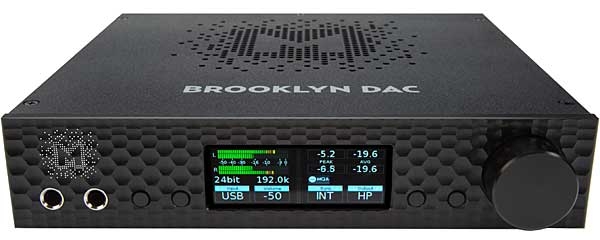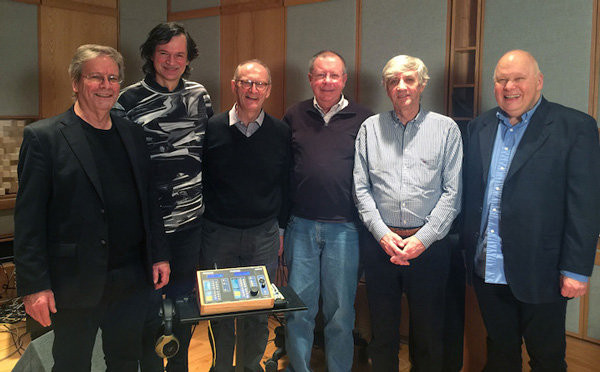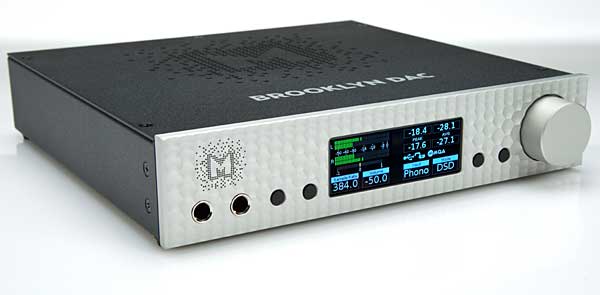| Columns Retired Columns & Blogs |
Niche: Audiophilia
Micro-niche: MQA
Nano-niche: Multichannel MQA

A year or so later, Meridian announced Master Quality Authenticated (MQA), and soon formed a new company, MQA Limited, to bring it to market. Many demonstrations were offered at CES and other trade shows, and at audio dealers in major cities. Typically, these consisted of listening to familiar recordings that had been processed with MQA, but rarely did Bob Stuart offer A/B comparisons with the originals—a tactic that seemed to me unconvincing, despite my being generally impressed with the sound quality I heard. In fact, because of the lack of such comparisons, I was most impressed by the MQA versions of the very oldest recordings played. What Stuart did offer at these demos was an insight into the technology of MQA, which consists of three components (footnote 1):
1) To compensate in the encoding for the unique characteristics of the ADC used in the original recording chain, it's necessary to incorporate into the file data about those specific devices. In addition, the user's DAC must have firmware that will also allow MQA to neutralize the DAC's fingerprint on the analog output.
2) While nowadays it's common to use higher resolutions for recording and playback, it's hard to accept that the value of hi-rez can be in the domains of amplitude or frequency. The 144.49dB theoretical signal/noise ratio of a 24-bit signal supports a potential dynamic range of 144.49dB, which far exceeds the range of human hearing (120–130dB, from threshold of hearing to threshold of pain) or, indeed, that of modern audio electronics. Similarly, sampling rates of 96 or 192kHz support frequency responses of up to 48 or 96kHz, respectively, both well above the commonly accepted upper limit of human hearing sensitivity of 20kHz. However, to preserve accuracy in the microsecond range—in which humans have a demonstrated ability to resolve time differences—the contents of MQA files can have a time resolution up to 384kHz sampling.
3) Of course, while many of us have systems that can handle recordings of resolutions up to 24/384, the downside is that such files are huge, voraciously eat up storage space, and require considerable time and bandwidth to download or stream. So MQA has implemented a protocol for "folding" such wide-bandwidth data into more compact form at lower resolutions, 24/44.1 or 24/48, for more efficient storage and streaming, as well as compatibility with the majority of contemporary audio hardware. It does so by embedding the audio information above 44.1kHz in two batches in the 24/44.1 band, but below the level of the recording's noise floor. The result is a compatible (CD equivalent) file that can easily be stored, streamed, and played at CD resolution, but can also be unfolded, like an origami sculpture, with MQA decoding.
MQA-encoded files can be lossless-compressed 16/44.1 or 16/48 FLAC files, that must be unfolded with MQA software and hardware to realize MQA's claimed improvement in sound. Some applications, such as Tidal (which I haven't tested), will perform the first unfolding, generally to 24/96, but further unfolding the origami to the full bandwidth of the original recording requires MQA-enabled hardware.
No mention was made, at the time of MQA's unveiling, of multichannel recordings, or of whether the decoding process would permit the insertion of filters for room correction or other purposes. When I asked about these, Stuart said that although MQA could support multichannel, that had yet to be addressed, and that it was theoretically possible to allow for additional DSP in the future.

MQA with multiple Myteks!
In January 2016, at CES, I was treated to a good demonstration of MQA by Michal Jurewicz, of Mytek HiFi, who streamed music from 2L Recordings through his new Brooklyn DAC, switching MQA decoding on and off. Through headphones, I found it easy to distinguish the two versions, and preferred the MQA. When I asked Jurewicz if I could hook up three Mytek Brooklyns to get 5.1-channel MQA playback, in an arrangement similar to what I reported on in July 2013 about using three of his Stereo192-DSD DACs, he smiled, said that it should be possible, but that as yet there were no multichannel MQA recordings.

At last September's CEDIA Expo, Jurewicz and I talked about this again, but this time we decided to do something about it. I e-mailed 2L's Morton Lindberg about creating some multichannel MQA files (he's already released some two-channel MQA recordings), and he agreed. Both Lindberg and Jurewicz then contacted Bob Stuart, who set the wheels in motion. He took the hi-rez 5.1-channel multichannel recordings I'd requested, separated them into pairs of channels—Front Left and Right, Center and Subwoofer, Surround Left and Right—converted each pair to MQA, then recombined them into 5.1-channel FLAC files. Shortly thereafter, Jurewicz sent me three Brooklyn DACs ($1995 each), and I prepared with great anticipation—but, I hoped, not unreasonable expectations.
My earlier experiment with multiple Mytek DACs had required a special ASIO driver so that my PC-based server, comprising JRiver Media Center and Baetis XR3, would recognize the three Myteks, connected via an active USB hub, as a single multichannel DAC. This time there was no need for a special driver, but it was necessary to use a Mac rather than a PC, because the Mac OS's audio-device setup protocol supports the aggregation of multiple connected audio devices into a single logical multichannel device. As luck would have it, I was able to inherit an Apple MacBook Pro from my granddaughter, who was moving on to a new one, and I put it to work with the Myteks. I updated the Mac's OS to Sierra 10.12.2, installed JRiver Media Center 22, and connected it to a simple USB hub feeding the Mytek DACs. One DAC was set up as the Master, and its clock output was daisy-chained to the other two. Audio Device setup let me assign and each channel before attempting to play music. The three Mytek Brooklyns were connected to a multichannel input on a 7.1-channel Parasound Halo P 7 preamplifier with six Kubala-Sosna Anticipation interconnects terminated with RCA plugs.

Niche: Audiophilia
Micro-niche: MQA
Nano-niche: Multichannel MQA

Granted but it's in such obscure niches where one finds the gems. ;-)

I wasn't sure i understood the problem with room correction DSP and MQA. If the dac converts prior to sending to a processor or sends the unfolded MQA stream digitally to a processor, and suppose the processor is the unit applying room correction, what would be the issue?

But after the DAC, you have analog. So, in order to do any DSP, you would have to redigitize the signals. As a result, yes, you would have MQA but it is probable that any advantage that may be would be negated by any additional analog-to-digital-to-DSP-to-digital machinations.

All the USB DAC's were synchronized by WCLK in a daisy chain. How did you checked out, that there is no delay between L/R + C/LFE + SL/SR?

I didn't but I imagine that it is the reason for synchronizing the WCLK. If you suspect that there is a problem with this procedure (I have no reason to believe there is), ask Mytek.
FWIW, I erred, once or twice, in setting the CLK for one of the DACs to "Internal" and the sound was not good.

There is no doubt about the WLCK interconnection, that the DAC are in sync. Normal consumer OS are not able to give out a proper sync.
The question was about a constant shift between the stereo DAC.
E. g. the L/R could be earlier like the C/LFE and SL/SR are somewhere. You won't recognice it so easily, because there will be no extra distortion. Just the soundfield will be somehow different.
Was there any procedure to do?

Understand that point but there is no procedure involved as far as I know. The L/R DAC generates the CLK which is sent to the C/Sub DAC and then relayed to the SL/SR DAC. I doubt that this is a problem considering that the links were very short and any timing differences would be inordinately less than those caused by speaker placement errors on the sub-millimeter level.
Again, if you are concerned about this, ask Mytek as I am not bothered by it.

I really appreciated this column on MQA; I plan now to closely follow its commercial development.
I noticed in Manufacturers' Comments in the hard copy of Stereophile in which your column originally appeared that MQA's Bob Stuart observed that it is technically possible to perform EQ and other DSP in MQA, so I'm hoping that when multichannel MQA enabled units are ultimately sold to the public it will integrate DSP.
Multichannel DSD has the same problem. I am particularly concerned with speaker distance adjustments and bass management being only as good as the "fidelity" of the DSD to PCM conversion mechanics. Have you found a way to handle DSP purely in DSD?

I have not found an effective way to do DSP in DSD but I have also not found any significant disadvantage to DSD-to-PCM conversions.

I understand the necessity of DSD to PCM conversion when playing a multichannel SACD. But given the large file sizes, isn't more practical to stick to high resolution PCM multichannel downloads in FLAC, given that it is highly likely that the master was in DSD and the PCM conversion has already been made in the mixing process?
P.S. I really enjoy your Stereophile column; it is the first thing I look for when I open my copy of the magazine.

I am not concerned with the file size and I do not see a consistent advantage for PCM or DSD given the wide range of available resolutions.
Generally, I download in the format and resolution in which the recording was made, if that information is available.
Thanks for your comments.

I have trouble understanding what the resistance to multi-channel is. Its superiority seems so obvious to me--truly glorious when well-implemented! A real advance in recorded music, IMO.
Thank you for your efforts--it seems like MC might disappear without it. I buy many of your recommended recordings, too. The 2L recordings are incredible!

I acquired a copy of Reflections based on your review, and I received it yesterday. I noticed that there are a number of versions of the album in different formats, with different resolutions. It looks like the one to focus on is the 5.1 DTS-HD 24/384 copy, but I also wanted to mention that there is a lower resolution copy mastered (encoded? not certain of the appropriate verb here) in ATMOS, which should be fun to compare.
I also found to my delight that you can extract MQA encoded FLAC files, so I now have a great collection of 24/384 MQA titles to listen to on my MQA capable media player.
Interestingly, these are all on a Blu-Ray Audio disc, but they also include a copy on SACD. May I assume that the SACD version will be inferior to the 5.1 DTS-HD version or would I be in error in thinking that?
I'm very much looking forward to listening to this over the weekend. And it all of a sudden occurs to my why I might want full range speaker for my surround channels, since with this recording there is no "front" orientation, you are truly in the center of the action from what I understand.
Thanks for the recommendation. While I tracked down the winner of the Grammy for Surround recording, I also spotted that Dire Straits "Love Over Gold" is also available, one of my very favorite albums, so one of this is UPS'ing it's way to me at this very moment. Have you heard it? What did/do you think of it?
***UPDATE***
I listened to Reflections several times this weekend, what a wonderful recording! I settled on listening to the 5.1 DTS-HD version for a full listening, but experimented with the Atmos copy too. Overall, I think the Atmos copy did a slightly better job of the surround placement of instruments, but the lower resolution (96k) was a bit of a drawback when compared to the 384k DTS-HD version. I listened to the stereo MQA tracks on my Pioneer PMP and that sounded just outstanding, even on my lesser bedroom system.
There is also a SACD copy - I wonder, are there any advantages that this version may have that the ones on the Blu-Ray do not?

I need a little advice. what are the best usb cables and hub for HIFI to connect a BlueSound vault to a PC and a DROBO? Any help is much appreciated.